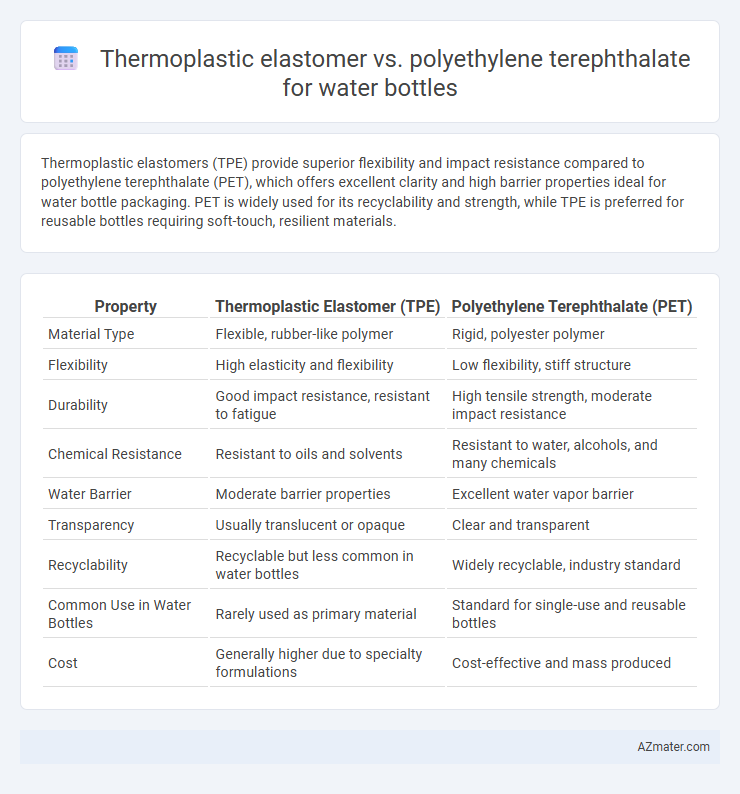Thermoplastic elastomers (TPE) provide superior flexibility and impact resistance compared to polyethylene terephthalate (PET), which offers excellent clarity and high barrier properties ideal for water bottle packaging. PET is widely used for its recyclability and strength, while TPE is preferred for reusable bottles requiring soft-touch, resilient materials.
Table of Comparison
| Property | Thermoplastic Elastomer (TPE) | Polyethylene Terephthalate (PET) |
|---|---|---|
| Material Type | Flexible, rubber-like polymer | Rigid, polyester polymer |
| Flexibility | High elasticity and flexibility | Low flexibility, stiff structure |
| Durability | Good impact resistance, resistant to fatigue | High tensile strength, moderate impact resistance |
| Chemical Resistance | Resistant to oils and solvents | Resistant to water, alcohols, and many chemicals |
| Water Barrier | Moderate barrier properties | Excellent water vapor barrier |
| Transparency | Usually translucent or opaque | Clear and transparent |
| Recyclability | Recyclable but less common in water bottles | Widely recyclable, industry standard |
| Common Use in Water Bottles | Rarely used as primary material | Standard for single-use and reusable bottles |
| Cost | Generally higher due to specialty formulations | Cost-effective and mass produced |
Introduction to Thermoplastic Elastomer and Polyethylene Terephthalate
Thermoplastic elastomers (TPE) combine the elasticity of rubber with the processability of plastics, making them flexible and resistant to deformation, ideal for applications requiring durability and impact resistance. Polyethylene terephthalate (PET) is a lightweight, strong polyester widely used in water bottles due to its excellent barrier properties against moisture and gases, ensuring beverage freshness. TPE offers superior flexibility and softness, while PET provides rigidity and clarity, influencing their respective suitability in water bottle manufacturing.
Material Composition and Chemical Properties
Thermoplastic elastomers (TPE) consist of a blend of polymers that exhibit both thermoplastic and elastomeric properties, characterized by flexible, rubber-like behavior due to segmented block copolymers. Polyethylene terephthalate (PET) is a semi-crystalline polyester made from terephthalic acid and ethylene glycol, known for its high strength, chemical resistance, and thermal stability. While TPE offers elasticity and impact resistance for reusable water bottles, PET provides excellent barrier properties and durability, making it ideal for single-use and recyclable water bottles.
Mechanical Strength and Durability Comparison
Thermoplastic elastomers (TPE) offer superior flexibility and impact resistance compared to polyethylene terephthalate (PET), making TPE more resilient under mechanical stress and deformation. PET exhibits higher tensile strength and rigidity, providing excellent structural integrity and resistance to cracking under pressure, which is crucial for maintaining bottle shape and safety during use. While PET bottles excel in durability for long-term storage due to their resistance to environmental factors, TPE's mechanical properties allow for better shock absorption, enhancing the bottle's lifespan under dynamic or high-impact conditions.
Flexibility and Design Versatility
Thermoplastic elastomers (TPE) offer superior flexibility compared to polyethylene terephthalate (PET), allowing water bottles to withstand bending and squeezing without cracking. TPE's design versatility enables the creation of ergonomic, soft-touch surfaces and complex shapes, enhancing user comfort and aesthetics. In contrast, PET provides rigidity and clarity but lacks the elastic properties necessary for innovative flexible bottle designs.
Weight and Ergonomics in Bottle Manufacturing
Thermoplastic elastomers (TPE) offer superior flexibility and lightweight properties compared to polyethylene terephthalate (PET), making bottles easier to grip and handle during manufacturing and consumer use. PET provides higher rigidity but increases the overall weight of the water bottle, potentially reducing ergonomic comfort. Combining TPE's lightweight and flexible nature with PET's durability can optimize both the weight and ergonomics in water bottle production.
Safety and Food-Grade Compliance
Thermoplastic elastomers (TPEs) used in water bottles offer excellent flexibility and impact resistance while meeting FDA and EU food-grade safety regulations, ensuring they DO NOT leach harmful chemicals into liquids. Polyethylene terephthalate (PET) is widely recognized for its superior barrier properties, BPA-free composition, and compliance with stringent food safety standards, making it a preferred choice for single-use and recyclable water bottles. Both materials are rigorously tested for chemical migration and toxicity to guarantee consumer safety in hydration products.
Environmental Impact: Recyclability and Biodegradability
Thermoplastic elastomers (TPE) offer improved recyclability compared to polyethylene terephthalate (PET) due to their ability to be remolded multiple times without degrading performance, though PET remains widely recycled through established municipal programs. PET's biodegradability is minimal, persisting in the environment for hundreds of years, whereas certain TPE formulations may degrade faster under specific conditions but are generally not fully biodegradable. Both materials pose environmental challenges; PET benefits from extensive recycling infrastructure, while TPE's environmental impact depends on its specific chemical composition and recycling system availability.
Cost Analysis for Production and Manufacturing
Thermoplastic elastomers (TPE) generally involve higher raw material costs compared to polyethylene terephthalate (PET) due to their complex polymer structures and lower production volumes. PET benefits from well-established, large-scale manufacturing processes, resulting in lower per-unit costs and higher production efficiency for water bottles. While TPE offers flexibility and durability advantages, PET's cost-effective production and recyclability make it the more economical choice for mass water bottle manufacturing.
Consumer Preferences and Market Trends
Thermoplastic elastomers (TPE) offer enhanced flexibility and durability compared to polyethylene terephthalate (PET), making them increasingly popular among consumers seeking reusable and impact-resistant water bottles. PET remains favored for single-use bottles due to its lightweight, crystal-clear appearance, and cost-effectiveness, aligning with mass-market demands. Current market trends indicate a growing consumer shift towards sustainable alternatives, boosting TPE's appeal in eco-friendly and customizable water bottle designs.
Conclusion: Choosing the Right Material for Water Bottles
Thermoplastic elastomers (TPE) offer flexibility, impact resistance, and enhanced grip, making them ideal for reusable water bottles requiring durability and comfort. Polyethylene terephthalate (PET) excels in lightweight, cost-effective, and recyclable water bottles with excellent clarity and barrier properties for single-use applications. Selecting the right material depends on the balance between reusability, mechanical performance, and environmental impact, with TPE favored for long-term use and PET for disposable solutions.

Infographic: Thermoplastic elastomer vs Polyethylene terephthalate for Water bottle
 azmater.com
azmater.com